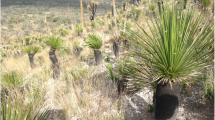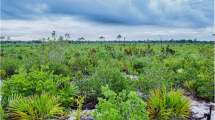Abstract
Experimental fire treatments were carried out by applying a propane torch flame to individual stumps ofArbutus unedo andErica arborea, two dominant ericaceous shrubs living in relatively moist maquis of the western Mediterranean Basin. No mortality was observed in either species. Individual plant size, measured as the individual stump area, was the most important factor determining both number and biomass of resprouts for all fire treatments. The number of resprouts at 3 months was less at the higher temperature, but no difference could not be detected at 18 months. Duration of flame application had no effect on resprouting success. This effect was not statistically significant 18 months after treatments were applied. Biomass of resprouts was not clearly affected by different fire treatments either 3 months or 18 months after the start of the resprouting process.
Similar content being viewed by others
References
Abacus Concepts 1989. SuperAnova. Abacus Concepts Inc., Berkeley.
Aubert B. 1975. Les Ericacées en Provence. Répartition, édaphologie, phytosociologie, croissance et floraison. Thèse de doctorat. Fac. Marseille.
Christensen N. L. 1985. Shrubland fire regimes and their evolutionary consequences. In: Pickett S. T. A. & White P. S. (eds), The ecology of natural disturbance and patch dynamics, pp. 86–100. Academic Press, New York.
Debano L. F. & Conrad C. E. 1978. The effect of fire on nutrients in a chaparral ecosystem. Ecology 59: 489–497.
Flinn M. A. & Wein R. W. 1977. Depth of underground plant organs and theoretical survival during fire. Can. J. Bot. 55: 2550–2554.
Gill A. M. 1981. Fire adaptaive traits of vascular plants. Proc. Conf. Fire Regimes and Ecosystems Properties. USDA. For. Ser. Gen. Tech. Rep. WO 26: 208–230.
Gimingham C. H. 1960. Biological flora of British Isles;Calluna vulgaris (L.). Hull. J. Ecol. 48: 455–483.
Hanes T. L. 1971. Succession after fire in the chaparral of southern California. Ecol. Monog. 41: 27–52.
Jones M. B. & Laude H. M. 1960. Relationships between sprouting in chamise and the physiological condition of the plant. J. Range Manage. 13: 210–214.
Kayll A. J. & Gimingham C. H. 1975. Vegetative regeneration ofCalluna vulgaris after fire. J. Ecol. 53: 729–734.
Keeley J. E. & Zedler P. H. 1978. Reproduction of chaparral shrubs after fire: a comparison of sprouting and seeding strategies. Am. Midl. Nat. 99: 142–161.
López-Soria L. & Castell C. 1989. Recuperación de la vegetación mediterránea tras los incendios del verano de 1986: implicaciones para su conversación. Il Trobada d'estudiosos del Montseny. Diputació de Barcelona Monografias 18: 83–85.
Malanson G. P. & O'Leary J. F. 1982. Post-fire regeneration strategies of Californian coastal sage shrubs. Oecologia (Berl.) 53: 355–358.
Malanson G. P. & O'Leary J. F. 1985. Effects of fire and habitats on post-fire regeneration in Mediterranean-type ecosystems:Ceanothus spinosus chaparral and Californian coastal sage schrub. Acata Oecol/Oecol. Plant. 6: 169–181.
Malanson G. P. & Trabaud L. 1987. Ordination analysis of components of resilience in garrigue. Ecology 68: 463–473.
Malanson G. P. & Trabaud L. 1988. Vigour of post-fire resprouting byQuercus coccifera L. J. Ecol. 76: 351–365.
McLean A. 1969. Fire resistance of forest species as influenced by root systems. J. Range Manag. 22: 120–122.
Mesleard F. 1987. Dynamique, après perubations, de peuplements de deux Ericacées (Arbutus unedo L. etErica arborea L.) en Corse. Thèse, Académie de Montpellier, Université des Sciences et Techniques du Languedoc.
Mesleard F. & Lepart J. 1989. Continuous basal resprouting from a lignotuber.Arbutus unedo L. andErica arborea L., as woody Mediterranean examples. Oecologia (Berl.) 80: 127–131.
Mills J. N. 1986. Herbivores and early postfire succession in Southern California chaparral. Ecology 67: 1637–1649.
Mooney H. A. & Hobbs R. J. 1986. Resilience at the individual plant level. In: Dell D., Hopkins A. J. M. & Lamont B. B. (eds), Resilience in Mediterranean-type Ecosystems, pp. 65–82. Dr W. Junk, The Hague.
Moreno J. M. & Oechel W. C. 1989. A simple method for estimating fire intensity after a burn in California chaparral. Acta Oecol./Oecol. Plant. 10: 56–67.
Moreno J. M. & Oechel W. C. 1991. Fire intensity and herbivory effects on postfire resprouting ofAdenostoma fasciculatum in southern California chaparral. Oecologia (Berl.) 85: 429–433.
Naveh Z. 1974. Effects of fire in the Mediterranean region. In: Kozlowsky T. T. & Ahlgren C. E. (eds), Fire and Ecosystems, pp. 401–434. Academic Press, New York.
Naveh Z. 1975. The evolutionary significance of fire in the Mediterranean region. Vegetatio 29: 199–208.
Papio C. 1988. Respuesta al fuego de la principales especies de la vegetación de Garraf (Barcelona). Orsis 3: 87–103.
Riba M. & Terradas J. 1985. Regeneració d'un bruguerar d'Erica arborea i una brolla deCistus spp. sotmesos a estassada Orsis 1: 81–90.
Rundel P.W. 1981. Structural and chemical components of flammability. Proc. Conf. Fire Regimes annd Ecosystems Properties. USDA For. Ser. Gen. Tech. Rep. WO 26: 183–207.
Rundel P. W., Baker G. A., Parsons D. J. & Stohlgren T. J. 1987. Postfire demography of resprouting and seedling establishment byAdenostoma fasciculatum in the California chaparral. In: Tenhunen J. D., Catarino F. M., Lange O. L. & Oechel W. C. (eds), Plant-Response to Stress-Functional Analysis in Mediterranean Ecosystems, pp. 575–596. Springer-Verlag, Berlin.
Schlesinger W. H. & Gill D. S. 1980. Biomass, production, and changes in the availability of light, water, and nutrients during the development of pure stands of the chaparral shrub,Ceanothus megacarpus, after fire. Ecology 61: 781–789.
Sousa W. P. 1984. The role of disturbance in natural communities. Ann. Rev. Ecol. Syst. 15: 353–391.
Stohlgren T. J., Parsons D. J. & Rundel P. W. 1984. Population structure ofAdenostom fasciculatum in mature stands of chamise chaparral in the southern Sierra Nevada, California, Oecologia (Berl.) 64: 87–91.
Thomas C. M. & Davis S. D. 1989. Recovery patterns of three chaparral shrub species after wildfire. Oecologia (Berl) 80: 309–320.
Trabaud L. 1979. Etude du comportament du feu dans la Garrigue de Chene kermes à partir des températures et des vitesses de propagation. Ann. Sci. Forest. 36: 13–38.
Trabaud L. 1981. Man and fire: impacts on mediterranean vegetation. In: Di Castri F., Goodall D. W. & Specht R. L. (eds), Ecosystems of the world 11: Mediterranean-type shrublands, pp. 523–537. Elsevier, Amsterdam.
Trabaud L. 1984. Changements structuraux apparaissant dans une garrigue de chene de kermes soumise à différents régimes de feux contrôlés. Acta Oecol./Oecol Applic. 5: 127–143.
Trabaud L. 1987. Fire and survival traits of plants. In: Trabaud L. (ed), The role of fire in ecological systems, pp. 65–89. SPB Academic Publishing, The Hague.
Vines R. G. 1968. Heat transfer through bark, and the resistance of trees to fire. Aust. J. Bot. 16: 499–514.
Westman W. E., O'Leary J.F. & Malanson G. P. 1981. Effects of fire intensity, aspect and substrate on post-fire growth of Californian coastal sage scrub. In: Mooney H. A. & Margaris N. S. (eds), Components of productivity of Mediterranean-type ecosystems, pp. 151–179. W. Junk, The Hague.
Zammit C. 1988. Dynamics of resprouting in the lignotuberous shrubBanksia oblongifolia. Aust. J. Ecol. 13: 311–320.
Author information
Authors and Affiliations
Rights and permissions
About this article
Cite this article
Canadell, J., Lloret, F. & López-Soria, L. Resprouting vigour of two mediterranean shrub species after experimental fire treatments. Vegetatio 95, 119–126 (1991). https://doi.org/10.1007/BF00045210
Accepted:
Issue Date:
DOI: https://doi.org/10.1007/BF00045210




